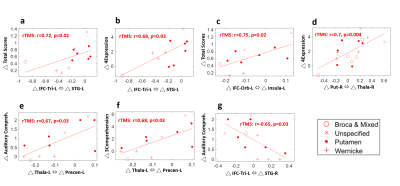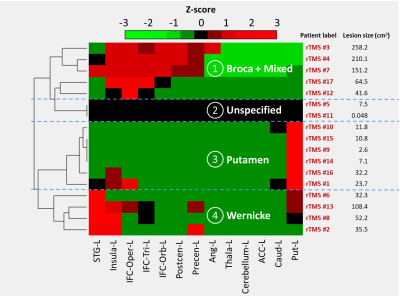Bing-Fong Lin1, Po-Yi Tsai2, and Chia-Feng Lu1
1Biomedical Imaging and Radiological Sciences, National Yang Ming University, Taipei, Taiwan, 2Physical Medicine and Rehabilitation, Taipei Veterans General Hospital, Taipei, Taiwan
1Biomedical Imaging and Radiological Sciences, National Yang Ming University, Taipei, Taiwan, 2Physical Medicine and Rehabilitation, Taipei Veterans General Hospital, Taipei, Taiwan
This study reported the efficacy of rTMS for improving language functions and inducing functional reorganization in aphasia patients. The individual lesion location and size may determine the functional circuits related to the language improvement after the inhibitory rTMS treatment.

Figure 3. Scatter plots with significant correlations (|r|>0.65, p<0.05) between change scores of language
performance and FCs of brain regions.

Figure 2. Hierarchical clustering based on the profiles
of overlapping percentage between stroke lesion and the selected cortex. The right-hand
side of each row shows patient label (by a given number) and the corresponding
lesion size. The columns are the selected brain regions related to the language
network. The color represents the values of z-scores (red for positive, and
green for negative value). The patients are clustered into four aphasia
subtypes based on lesion patterns, including Broca and mixed type, unspecified,
putamen, and Wernicke aphasia.